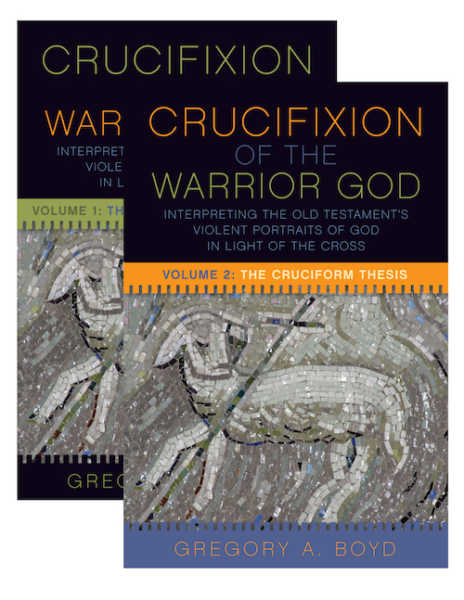We run our website the way we wished the whole internet worked: we provide high quality original content with no ads. We are funded solely by your direct support. Please consider supporting this project.

Crucifixion of the Warrior God Update
Did you know that authors generally don’t have much say-so about the cover art for their books? It’s considered part of the marketing, so the author may or may not like how it ends up looking. I’ve had a few book covers that made me scratch my head. (I won’t tell you which ones, but it would be fun to hear all of your guesses.) That being said, I’m thrilled with these covers, and I wanted to share them with all of you. So exciting!
Here’s the Fortress Press description:
A dramatic tension confronts every Christian believer and interpreter of Scripture: on the one hand, we encounter images of God commanding and engaging in horrendous violence: one the other hand, we encounter the non-violent teachings and example of Jesus, whose loving, self-sacrificial death and resurrection is held up as the supreme revelation of God’s character in the New Testament. How do we reconcile the tension between these seemingly disparate depictions? Are they even capable of reconciliation? Throughout Christian history, many different answers have been proposed, ranging from the long-rejected explanation that these contrasting depictions are of two entirely different ‘gods’ to recent social and cultural theories of metaphor and narrative representation.
The Crucifixion of the Warrior God takes up the dramatic tensions between depictions of divinely sanctioned violence and the message of peace centering the New Testament. Over two volumes, Gregory A. Boyd argues that we must take seriously the full range of Scripture and the centrality of the crucified and risen Christ as God’s supreme revelation. Developing a theological interpretation of Scripture involves what Boyd calls a cruciform hermeneutic. This reading leads us into the proper way of understanding the character of God, revealing God as loving, sacrificial, and subverting violence.
Category: General
Tags: Crucifixion of the Warrior God, Cruciform Theology
Related Reading

Answering an Objection to a Cross-Centered Approach to Scripture
Through Greg’s Facebook and Twitter, we’ve been getting some great feedback and questions regarding his cross-centered approach to Scripture. Several have voiced questions similar to the reader’s (below), so we thought it would be helpful to post Greg’s answer here on his blog.

If Jesus Is the Whole Point, Then What’s the Point of the Old Testament? (podcast)
Greg considers the role of the Old Testament in Christian faith. Episode 554 http://traffic.libsyn.com/askgregboyd/Episode_0554.mp3

Getting Honest about the Dark Side of the Bible
Eddy Van 3000 via Compfight While most of the Bible exhibits a “God-breathed” quality, reflecting a magnificently beautiful God that is consistent with God’s definitive revelation on the cross, we must honestly acknowledge that some depictions of God in Scripture are simply horrific. They are included in what is sometimes called “the dark side of…

Cross-like Love and Non-Violence
Cosmo Spacely via Compfight Though it seems to have been forgotten by many today, the cross wasn’t simply something God did for us. According to the NT, it was also an example God calls us to follow. Hence, after John defined love by pointing us to Jesus’ death on the cross on our behalf, he…

How the Anabaptists Emphasized the Cross
Because the Anabaptists have generally emphasized faith that is evidenced by works and thus on Jesus’ life as an example to be followed, it may prima facia appear that the saving work of the cross was less central to the early Anabaptists than it was to the Reformers and to Evangelicals. In reality, I would argue,…

Does Paul Condone Vindictive Psalms? A Response to Paul Copan (#1)
In a recent paper delivered at the Evangelical Theological Society, Paul Copan raised a number of objections against my book, Crucifixion of the Warrior of God. This is the first of several blogs in which I will respond to this paper. (By the way, Paul and I had a friendly two-session debate on Justin Brierley’s…
